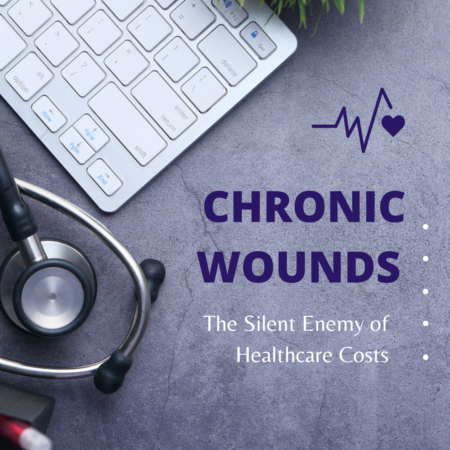 Chronic wounds are a major problem in the United States, costing billions of dollars in medical expenses each year. They are often hidden and difficult to detect, making it difficult to determine their exact impact on healthcare costs. This blog post will explore the issue of chronic wounds and how they are contributing to the high cost of healthcare in the US. We will examine the types of chronic wounds, the treatments available, and the strategies that can be used to reduce the financial burden of these conditions. Finally, we will look at the potential for new technologies and treatments that could make a significant difference in the cost of treating chronic wounds.
Chronic wounds are a major problem in the United States, costing billions of dollars in medical expenses each year. They are often hidden and difficult to detect, making it difficult to determine their exact impact on healthcare costs. This blog post will explore the issue of chronic wounds and how they are contributing to the high cost of healthcare in the US. We will examine the types of chronic wounds, the treatments available, and the strategies that can be used to reduce the financial burden of these conditions. Finally, we will look at the potential for new technologies and treatments that could make a significant difference in the cost of treating chronic wounds.
Understanding Chronic Wounds and Their Impact on Health Care Costs
Chronic wounds can have a significant impact on healthcare costs in the United States. These wounds, which take longer to heal and are often recurrent, require ongoing treatment and care. The cost of dressing materials, medications, and healthcare visits can add up quickly. Additionally, the impact of chronic wounds extends beyond direct medical expenses. Understanding the financial implications of chronic wounds is crucial for healthcare providers, policymakers, and patients alike.
The Prevalence of Chronic Wounds in the United States
Chronic wounds are a prevalent issue in the United States, affecting millions of individuals. From diabetic ulcers to pressure sores, these wounds can be debilitating and require long-term care. According to recent studies, approximately 6.5 million Americans are affected by chronic wounds, making them a significant healthcare concern.
The Direct and Indirect Costs of Chronic Wound Treatment
Chronic wound treatment comes with a heavy financial burden. The costs of dressing materials, medications, and frequent healthcare visits can quickly add up. But it’s not just the direct expenses that patients and healthcare providers have to consider. Chronic wounds can lead to prolonged hospital stays, decreased quality of life, and loss of productivity. These indirect costs further contribute to the high healthcare expenses associated with chronic wound treatment.
The Importance of Early Intervention and Prevention
Early intervention and prevention are crucial when it comes to chronic wounds. By addressing wounds promptly and taking preventive measures, patients can avoid complications and costly treatments. By emphasizing the need for proactive measures, patients can better manage their chronic wounds and reduce the burden on healthcare costs.
Finding the Right Wound Care Products
When it comes to finding the right wound care products, it’s important to consider the specific needs of your chronic wound. Different types of wounds require different treatments and dressings. Whether it’s hydrogels, foams, or antimicrobial dressings, finding the right product can help facilitate healing and prevent complications. Consulting with a healthcare professional or wound care specialist is crucial in determining the most effective products for your individual needs. Don’t hesitate to ask for guidance and explore different options to ensure optimal wound care.
Managing Discomfort During Healing
Managing discomfort during the healing process of chronic wounds is crucial for patient comfort and well-being. From using specialized dressings to alleviate pain and reducing pressure on the wound, there are various strategies to ensure a more comfortable healing experience. By working closely with healthcare professionals, patients can find personalized solutions to manage discomfort and promote healing. Prioritizing comfort during the healing journey can greatly improve the overall quality of life for individuals with chronic wounds.
The Role of Health Insurance in Covering Chronic Wound Treatment
When it comes to covering the costs of chronic wound treatment, health insurance plays a crucial role. Insurance plans can help alleviate the financial burden by providing coverage for medications, dressings, and healthcare visits. However, it’s important for patients to understand the specifics of their insurance coverage, including any limitations or requirements.
Improving Chronic Wound Management in the United States
To improve chronic wound management in the United States, it is crucial to prioritize research and innovation. Investing in new technologies, such as advanced wound dressings and wound care devices, can significantly enhance the healing process and reduce treatment costs. Additionally, increasing access to specialized wound care professionals and promoting interdisciplinary collaboration among healthcare providers can improve the quality of care for patients with chronic wounds. By continuously seeking ways to improve chronic wound management, we can reduce the financial burden and improve the overall well-being of individuals affected by these conditions.
How can Prism Medical Products help?
If you are a clinician seeing patients with chronic wounds, contact us to schedule an in service. Prism processes healthcare claims and submits to a patient’s insurance company, obtains payment for medical supplies from a patient’s health insurance, and communicates directly with both the patient and clinician or facility throughout the process.
